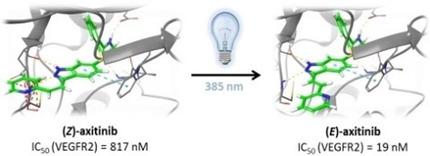当前位置:
X-MOL 学术
›
ChemMedChem
›
论文详情
Our official English website, www.x-mol.net, welcomes your feedback! (Note: you will need to create a separate account there.)
Axitinib: A Photoswitchable Approved Tyrosine Kinase Inhibitor
ChemMedChem ( IF 3.4 ) Pub Date : 2018-11-05 , DOI: 10.1002/cmdc.201800531 Dorian Schmidt 1 , Theo Rodat 1 , Linda Heintze 1 , Jantje Weber 1 , Rebecca Horbert 1 , Ulrich Girreser 1 , Tim Raeker 2 , Lara Bußmann 3, 4 , Malte Kriegs 4 , Bernd Hartke 2 , Christian Peifer 1
ChemMedChem ( IF 3.4 ) Pub Date : 2018-11-05 , DOI: 10.1002/cmdc.201800531 Dorian Schmidt 1 , Theo Rodat 1 , Linda Heintze 1 , Jantje Weber 1 , Rebecca Horbert 1 , Ulrich Girreser 1 , Tim Raeker 2 , Lara Bußmann 3, 4 , Malte Kriegs 4 , Bernd Hartke 2 , Christian Peifer 1
Affiliation

|
The goal of photopharmacology is to develop photoswitchable enzyme modulators as tunable (pro‐)drugs that can be spatially and temporally controlled by light. In this context, the tyrosine kinase inhibitor axitinib, which contains a photosensitive stilbene‐like moiety that allows for E/Z isomerization, is of interest. Axitinib is an approved drug that targets the vascular endothelial growth factor receptor 2 (VEGFR2) and is licensed for second‐line therapy of renal cell carcinoma. The photoinduced E/Z isomerization of axitinib has been investigated to explore if its inhibitory effect can be turned “on” and “off”, as triggered by light. Under controlled light conditions, (Z)‐axitinib is 43 times less active than that of the E isomer in an VEGFR2 assay. Furthermore, it was proven that kinase activity in human umbilical vein cells (HUVECs) was decreased by (E)‐axitinib, but only weakly affected by (Z)‐axitinib. By irradiating (Z)‐axitinib in vitro with UV light (λ=385 nm), it is possible to switch it almost quantitatively into the E isomer and to completely restore the biological activity of (E)‐axitinib. However, switching the biological activity off from (E)‐ to (Z)‐axitinib was not possible in aqueous solution due to a competing irreversible [2+2]‐photocycloaddition, which yielded a biologically inactive axitinib dimer.
中文翻译:

阿昔替尼:一种可光转换批准的酪氨酸激酶抑制剂
光药理学的目标是开发可通过光在空间和时间上控制的可调谐(前)药物,作为光可转换酶调节剂。在这种情况下,酪氨酸激酶抑制剂阿西替尼(axitinib)中含有感光二苯乙烯样部分,可以进行E / Z异构化,因此很受关注。阿昔替尼是一种针对血管内皮生长因子受体2(VEGFR2)的批准药物,已获准用于肾细胞癌的二线治疗。已经对阿西替尼的光诱导E / Z异构化进行了研究,以探索其抑制作用是否可以被光触发“打开”和“关闭”。在受控光照条件下,(Z在VEGFR2分析中,阿昔替尼的活性比E异构体低43倍。此外,已证明(E)-阿昔替尼降低了人脐静脉细胞(HUVECs)中的激酶活性,但仅受到(Z)-阿昔替尼的微弱影响。通过在体外用紫外线(λ = 385 nm)照射(Z)-阿昔替尼,可以几乎定量地将其转换为E异构体,并完全恢复(E)-阿昔替尼的生物活性。但是,将生物活性从(E)‐切换为(Z)-由于竞争性不可逆的[2 + 2]-光环加成反应,在水溶液中不可能出现阿昔替尼,从而产生了生物学上无活性的阿西替尼二聚体。
更新日期:2018-11-05
中文翻译:

阿昔替尼:一种可光转换批准的酪氨酸激酶抑制剂
光药理学的目标是开发可通过光在空间和时间上控制的可调谐(前)药物,作为光可转换酶调节剂。在这种情况下,酪氨酸激酶抑制剂阿西替尼(axitinib)中含有感光二苯乙烯样部分,可以进行E / Z异构化,因此很受关注。阿昔替尼是一种针对血管内皮生长因子受体2(VEGFR2)的批准药物,已获准用于肾细胞癌的二线治疗。已经对阿西替尼的光诱导E / Z异构化进行了研究,以探索其抑制作用是否可以被光触发“打开”和“关闭”。在受控光照条件下,(Z在VEGFR2分析中,阿昔替尼的活性比E异构体低43倍。此外,已证明(E)-阿昔替尼降低了人脐静脉细胞(HUVECs)中的激酶活性,但仅受到(Z)-阿昔替尼的微弱影响。通过在体外用紫外线(λ = 385 nm)照射(Z)-阿昔替尼,可以几乎定量地将其转换为E异构体,并完全恢复(E)-阿昔替尼的生物活性。但是,将生物活性从(E)‐切换为(Z)-由于竞争性不可逆的[2 + 2]-光环加成反应,在水溶液中不可能出现阿昔替尼,从而产生了生物学上无活性的阿西替尼二聚体。



























 京公网安备 11010802027423号
京公网安备 11010802027423号